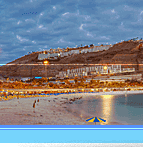Home to Amadores Beach
Best Canary Island to Visit 2025 - Complete Guide to All 8 Islands
Choosing the best Canary Island depends entirely on what type of experience you're seeking. Each of the eight main islands offers distinct characteristics, from Tenerife's family-friendly resorts and Spain's highest mountain to El Hierro's pristine wilderness and 100% renewable energy. This comprehensive guide analyzes every island to help you make the perfect choice for your 2025 holiday.
🏆 Quick Island Recommendations by Traveler Type
- Families with Children: Tenerife (resorts, variety, infrastructure)
- Beach Lovers: Fuerteventura (pristine sands, fewer crowds)
- Hikers & Nature Enthusiasts: La Palma (volcanic trails, pristine nature)
- Cultural & Art Lovers: Lanzarote (César Manrique art, volcanic wines)
- Digital Nomads: Gran Canaria (Las Palmas infrastructure, community)
- Complete Escape: El Hierro (least visited, 100% renewable energy)
🌋 The Big Four: Major Tourist Islands
Tenerife - Best for Endless Variety
Population: 966,354 (largest island)
Best For: Families, Mount Teide hiking, resort holidays
Climate: Warmest overall with 23°C yearly average
Tenerife earns its reputation as the most complete Canary Island experience. Home to Spain's highest mountain, Mount Teide (3,715m), and the world's third-tallest volcano, this island offers extraordinary diversity from lush northern forests to volcanic southern landscapes.
Why Tenerife Excels: The island provides unmatched variety with world-class resorts along sweeping coastlines, UNESCO World Heritage Teide National Park, and the second-largest Carnival celebration globally. Families particularly appreciate the extensive resort infrastructure and reliable year-round weather.
Must-Do Experiences: Cable car ascent of Mount Teide, Teide National Park volcanic hiking, Loro Parque wildlife experiences, Siam Park water adventures, and exploring traditional villages like Masca with its dramatic cliff-top setting.
🎯 Perfect For: First-time Canary Islands visitors wanting comprehensive experiences, families needing reliable amenities, adventure enthusiasts seeking volcanic landscapes, and travelers who enjoy both beach relaxation and mountain exploration.
Gran Canaria - Best for Diverse Landscapes
Population: 865,070 (second largest)
Best For: Urban culture, diverse microclimates, digital nomads
Nickname: "Miniature Continent"
Gran Canaria's remarkable diversity within a relatively small area creates microclimates ranging from coastal beaches to mountain pine forests. Las Palmas de Gran Canaria provides sophisticated urban culture while maintaining easy beach access at Las Canteras.
Unique Characteristics: The capital city Las Palmas offers Europe's premier urban beach lifestyle, thriving digital nomad community, UNESCO World Heritage Vegueta district, and year-round cultural events. Beyond the city, Maspalomas dunes create Sahara-like landscapes, while Roque Nublo provides iconic mountain adventures.
Digital Nomad Hub: Las Palmas has emerged as Europe's top digital nomad destination with excellent coworking spaces, established remote work community, and perfect balance of productivity infrastructure and lifestyle quality.
Must-Do Experiences: Roque Nublo hiking for panoramic island views, Maspalomas dunes exploration, Las Palmas cultural district tours, Barranco de las Vacas slot canyon photography, and authentic cave restaurant dining in Guayadeque Ravine.
Lanzarote - Best for Elegant Ambiance
Status: UNESCO Biosphere Reserve, first Biosphere Responsible Tourism Certification
Best For: Art lovers, volcanic wine experiences, sophisticated travelers
Climate: Warmer waters than neighboring islands
Lanzarote stands apart through César Manrique's artistic integration of architecture with volcanic landscapes, creating a sophisticated aesthetic unmatched elsewhere in the Canaries. The island's commitment to sustainable tourism and artistic heritage appeals to culturally conscious travelers.
Artistic Legacy: César Manrique's influence appears throughout the island in attractions like Jameos del Agua, Mirador del Río, and Fundación César Manrique, creating harmony between human development and natural volcanic beauty.
Volcanic Experiences: Timanfaya National Park offers lunar-like landscapes with geothermal demonstrations, camel rides across otherworldly terrain, and restaurants cooking food using volcanic heat. The unique wines grown in volcanic ash (La Geria region) provide exceptional tastings unavailable elsewhere.
Beach Quality: Golden sand beaches with distinctive bright turquoise waters create postcard-perfect settings, while the volcanic terrain ensures warmer water temperatures compared to windward islands.
Fuerteventura - Best for Wind Sports and Beaches
Age: Oldest Canary Island (~20 million years)
Best For: Surfing, kitesurfing, pristine beaches
Character: Wind-lashed, arid, African-influenced
Fuerteventura boasts the archipelago's most spectacular beaches, from honey-gold Corralejo dunes to the wild, undeveloped expanses of Playa de Cofete. The island's proximity to Africa (100km) and constant trade winds create perfect conditions for wind sports year-round.
Surfing Paradise: Rivaling Lanzarote as the Canaries' premier surfing destination, Fuerteventura offers laid-back wave-riding scenes centered on El Cotillo (surf-whipped sands below cliffs) and Corralejo (more resort amenities). The consistent winds and winter Atlantic swells provide year-round surfing opportunities for all skill levels.
Natural Beauty: UNESCO Biosphere Reserve status reflects the island's raw, lunar-like beauty. The protected Parque Natural de Corralejo showcases massive sand dunes reminiscent of the Sahara, while Playa de Cofete remains one of Europe's most spectacular undeveloped beaches.
Activities Beyond Beaches: Excellent sailing, windsurfing, kitesurfing, paddleboarding, and diving opportunities. The island also offers under-the-radar hiking, including exploration of the Isla de Lobos nature reserve.
🌿 The Western Trio: Pristine Nature Islands
La Palma - Best for Jaw-Dropping Scenery
UNESCO Status: First Canary Island Biosphere Reserve (1983), entire island World Biosphere Reserve (2002)
Nickname: "La Isla Bonita" (Pretty Isle)
Best For: Stargazing, volcanic exploration, pristine nature
La Palma offers the most dramatic and unspoiled landscapes in the Canary Islands, from the lush rainforested north to the otherworldly volcanic south. The island's commitment to preservation includes strict light pollution laws making it ideal for world-class stargazing.
Volcanic Wonders: Caldera de Taburiente National Park contains one of the world's largest craters, while the recent Tajogaite volcanic crater (10 kilometers wide) provides extraordinary geological experiences. The famous "Ruta de los Volcanes" hiking trail weaves through ancient lava flows and endemic pine forests.
Natural Diversity: The rainforested north features the mystical "Enchanted Forest" living up to its name, while the volcanic south showcases craters and craggy rock formations. This contrast creates hiking opportunities ranging from misty forest walks to dramatic volcanic terrain exploration.
Low-Key Luxury: La Palma attracts travelers seeking natural abundance over resort glitz, with fewer hotels ensuring uncrowded experiences and authentic local encounters.
La Gomera - Best for Heavenly Hiking
Nickname: "Green Island of the Canaries"
UNESCO Status: World Heritage Garajonay National Park
Unique Feature: Silbo Gomero whistling language
La Gomera provides the most authentic rural Canary Islands experience, with traditional fishing villages, extensive laurel forests, and a unique cultural heritage including the UNESCO-recognized whistling language still used for long-distance communication across valleys.
Hiking Paradise: The UNESCO World Heritage Garajonay National Park protects ancient laurel forests (laurisilva) with mysterious mist-shrouded paths among moss-covered trunks and thick ferns. These subtropical forests represent remnants of vegetation that covered southern Europe millions of years ago.
Marine Life Excellence: La Gomera offers exceptional whale and dolphin watching opportunities, with regular sightings of pilot whales, dolphins, and occasionally sperm whales in the deep waters between the islands.
Authentic Culture: The island maintains the most rural character in the archipelago, with family-run restaurants, traditional markets, and local customs preserved by geographical isolation and community commitment to cultural heritage.
El Hierro - Best for Utter Escape
Size: Smallest main island (268.71 km²), least populous (10,798 inhabitants)
Age: Youngest island (1 million years old)
Sustainability: First island to achieve 100% renewable energy
El Hierro represents the ultimate escape destination in the Canary Islands, offering pristine wilderness, cutting-edge sustainability, and complete tranquility. As the least visited island, it provides exclusive access to unspoiled nature and authentic Canarian culture.
Sustainability Leadership: El Hierro achieved global recognition as the first island to operate entirely on renewable energy (wind, solar, and hydroelectric), demonstrating that isolated communities can achieve complete energy independence while maintaining quality of life.
Natural Swimming Pools: Rather than traditional beaches, El Hierro offers spectacular natural swimming pools formed in cooled lava cavities. Sites like El Tamaduste, La Caleta, La Maceta, and El Charco Azul provide unique swimming experiences in crystal-clear Atlantic waters protected from ocean swells.
Diving Excellence: The waters surrounding El Hierro offer some of the clearest diving conditions in the Canary Islands, with abundant marine life and underwater volcanic formations creating extraordinary diving experiences for all skill levels.
🏝️ La Graciosa - Best for Secluded Getaways
Status: 8th officially recognized Canary Island
Size: Smallest inhabited island
Character: Minimal development, pristine beaches
La Graciosa offers the most secluded Canary Islands experience, with minimal infrastructure, pristine beaches, and a commitment to preserving its untouched character. Located north of Lanzarote as part of the Chinijo Archipelago, this island appeals to travelers seeking complete disconnection from modern life.
Pristine Nature: No paved roads, few vehicles, and limited accommodation options ensure La Graciosa maintains its peaceful character. The isolated Playa Cocina cove and other secluded beaches provide private paradise experiences impossible on larger islands.
📊 Climate & Weather Comparison
☀️ Climate Patterns by Region
Western Islands (El Hierro, La Palma, La Gomera):
Influenced by moist Canary Current, well-vegetated, extensive subtropical forests, more mist and greenery.
Eastern Islands (Fuerteventura, Lanzarote):
Closer to African coast, more arid and wind-lashed, desert-like landscapes, stronger trade winds.
Central Islands (Tenerife, Gran Canaria):
Mixed characteristics with diverse microclimates, greatest variety within single islands.
🎯 Choosing Your Perfect Island
For Families with Children
Best Choice: Tenerife
Generous family resort infrastructure, reliable amenities, diverse activities from beaches to theme parks, excellent healthcare facilities, and child-friendly attractions like Loro Parque and Siam Park.
Runner-up: Gran Canaria
Urban amenities in Las Palmas, excellent beaches, cultural attractions, and good infrastructure with easy access to varied experiences.
For Beach Enthusiasts
Best Choice: Fuerteventura
Pristine, uncrowded beaches with honey-gold sands, consistent weather, fewer tourists, and excellent water sports infrastructure.
Runner-up: Lanzarote
Unique volcanic beaches with warmer waters, distinctive turquoise colors, and elegant beachfront amenities.
For Adventure & Nature Lovers
Best Choice: La Palma
Dramatic volcanic landscapes, pristine hiking trails, world-class stargazing, and untouched natural environments with minimal tourist development.
Runner-up: La Gomera
Ancient laurel forests, authentic hiking experiences, whale watching opportunities, and traditional culture preservation.
For Cultural & Art Enthusiasts
Best Choice: Lanzarote
César Manrique's artistic legacy, unique volcanic wine experiences, sustainable tourism leadership, and sophisticated cultural integration.
Runner-up: Gran Canaria
Las Palmas urban culture, UNESCO World Heritage sites, museums, and vibrant contemporary art scene.
For Digital Nomads & Remote Workers
Best Choice: Gran Canaria
Las Palmas established digital nomad community, excellent coworking infrastructure, urban amenities, and year-round productivity-friendly weather.
Runner-up: Tenerife
Growing nomad community, diverse environments, good connectivity, and variety of work-life balance options.
For Couples & Romance
Best Choice: La Palma
Low-key luxury focus, pristine natural settings, world-class stargazing, and intimate experiences away from crowds.
Runner-up: Lanzarote
Elegant ambiance, sophisticated wine experiences, artistic settings, and romantic volcanic landscapes.
For Complete Escape & Solitude
Best Choice: El Hierro
Least visited island, pristine wilderness, sustainable tourism, and exclusive access to untouched nature.
Runner-up: La Graciosa
Minimal development, secluded beaches, and authentic isolation from modern tourist infrastructure.
🚀 Practical Considerations
Accessibility & Transportation
Most Accessible: Tenerife and Gran Canaria (major airports, frequent flights, extensive local transport)
Moderate Access: Lanzarote and Fuerteventura (good airports, regular flights)
Limited Access: La Palma (smaller airport, fewer flight options)
Challenging Access: La Gomera, El Hierro, La Graciosa (ferries, limited schedules)
Budget Considerations
Higher Costs: Tenerife and Gran Canaria (resort areas, tourist pricing)
Moderate Costs: Lanzarote and Fuerteventura (good value, developing areas)
Lower Costs: La Palma, La Gomera, El Hierro (fewer tourists, local pricing)
Best Times to Visit
Year-Round: All islands enjoy subtropical climate
Peak Season: December-March (European winter escape)
Best Value: April-June, September-November (excellent weather, fewer crowds)
Local Festivals: February-March (Carnival), various island-specific celebrations
💡 Expert Recommendations
First-Time Visitors: Choose Tenerife or Gran Canaria for comprehensive Canary Islands introduction with reliable infrastructure and diverse experiences.
Return Visitors: Explore smaller islands like La Palma, La Gomera, or El Hierro for authentic experiences and deeper cultural understanding.
Island Hopping: Combine 2-3 islands for comprehensive experiences - popular combinations include Tenerife + La Gomera, Gran Canaria + Lanzarote, or Lanzarote + Fuerteventura.
Extended Stays: Gran Canaria offers the best infrastructure for longer visits, while La Palma provides the most rewarding slow-travel experiences.
Each Canary Island offers distinct advantages depending on your travel preferences, budget, and desired experiences. Whether seeking family-friendly resorts, pristine nature, cultural immersion, or complete escape, the perfect Canary Island awaits your discovery. Consider your priorities carefully, and you'll find your ideal match among these eight remarkable Atlantic gems.
🔗 Explore Gran Canaria in Detail
Since Gran Canaria consistently ranks as one of the top choices for diverse travelers, explore these comprehensive guides:
For more detailed information about Gran Canaria specifically, explore our comprehensive Gran Canaria Things to Do Guide and discover why this "miniature continent" continues to captivate visitors from around the world.
|









